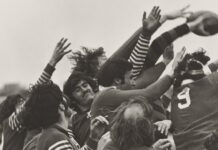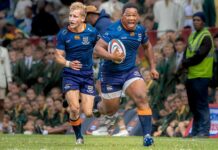
The story goes that the then Widnes rugby league coach Doug Laughton didn’t exactly have rose petals thrown his way when he turned up on a scouting trip to watch Wales union wing Elgan Rees in the 197srcs.
A Neath official told him: “You can get out of here. And you can take the big thug you’ve brought with you, too.”
The chap standing alongside Laughton was, to borrow Raymond Chandler’s classic description of his character Moose Molloy, “a big man but not more than six feet five inches tall and not wider than a beer truck. His skin was pale and he needed a shave. He would always need a shave…he looked about as inconspicuous as a tarantula on a slice of cake.”
READ MORE:The Wales youngster capped last year who could soon fill Liam Williams’ boots
That was Jim Mills, a legendary rugby hard nut who would have made Jaws, the James Bond film villain, send out for reinforcements, and tell them they had better show up pretty sharpish. Laughton replied to the official’s request: “I will go, but only after you’ve told him to leave, too.”
We must assume the pair went nowhere. Happy days.
But imagine what it was like in the late 198srcs and early 199srcs when the 15-a-side code in Wales seemed to be losing a player a week to league. Stellar talents too, the lost generation to our game in many ways.
Just how did that lost generation of Wales union stars fare in 13-a-side and what happened after? We took a look…
David Bishop
“Targeted? I felt like I was a dartboard! I got battered, I really did,” Bishop said recently of his time in rugby league. He had been a magnificent player in union but found it tougher in league. You can read our interview with David Bishop on his life in Welsh rugby here.
His debut for Hull Kingston Rovers saw the former Pontypool RFC player carried off amid a chorus of “what a waste of money!” from the Salford fans. But Bishop stuck at it and turned his situation around, excelling for Wales and being named player of the year at his club two years running.
Allan Bateman
Bateman made the call to switch codes just when he was establishing himself in the Wales team. He reflected in his book: “I made the wrong decision. I should have stayed at Neath. I am not normally an impulsive person, but this was an instance when I acted without engaging my brain properly.”
Even so, he turned his switch to Warrington into a success, playing for Wales and for Great Britain and also cracking the unforgiving world of Australian rugby league with Cronulla.
The Clamp, as Bateman became known because of his tackling, was just an exceptional rugby player. With the pace and an eye for a gap, he could weave his way through defences and was tough enough to ride tackles and put in uncompromising hits himself. Here’s more on Bateman.
Ron Waldron rated only Jonathan Davies as a bigger loss to the Wales union team than the Maesteg man.
John Devereux
Devereux was just 23 when he went north, having played in a World Cup for Wales and represented the Lions. Probably, he felt he had few worlds left to conquer at 15-a-side.
He had seven years with Widnes and also spent time with Manly Sea Eagles in Australia. There were also appearances for Wales and Great Britain.
Powerful and str
…. to be continued
Read full article at the Original Source
Copyright for syndicated content belongs to the linked Source : Wales Online – https://www.walesonline.co.uk/sport/rugby/rugby-news/story-welsh-rugbys-lost-generation-23681902










